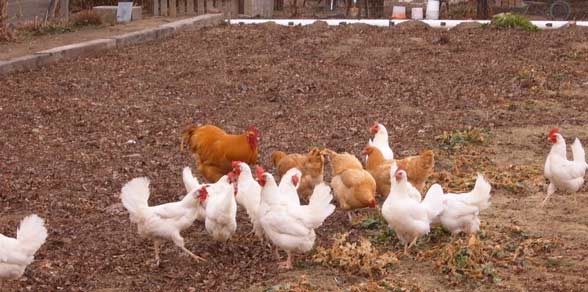Purchase feed from a reputable miller who can assure consistency in the quality and performance of the feed. Avoid mixing feeds from several millers, adding other protein sources like fish, meal and minerals salts (DCP) as this changes the balance in the feed thereby affecting performance. Excess of some of these products also negatively affects the final products for instance fishy taint in eggs due to more than 5% fish meal in feed.
During the changes of the rations, mix the two rations so that the change is gradual. An abrupt change is stressful to the bird and can affect performance. Vitamins can be provided during this time to reduce the stress.
Layer chicks
From day 1 to 8 weeks they are feed on chick mash, after 8 weeks introduce growers mash gradually, then with layers mash after drop of first egg at around 23 weeks old. The starter feed should contain 18-20% CP and approximately 3,000 kcal ME/kg from 0 to 6 wk of age. The grower feed should contain 14-16% CP and about 3,000 kcal ME/kg from 6 to 12 wk of age.
To start a flock, feeder lids or plastic feeder trays (one per 50 chicks) should be used. Feed should also be spread on paper placed over the litter, covering 40% of the floor.
Gradually remove the feeder lids or trays, replacing them with the adult feeders. By the time the birds are two weeks (14) days old, all the lids and trays should have been removed. Raise the feeders gradually as the birds grow. Always ensure that the top lip of the feeder is at the same level with the birds’ backs. Provide adequate feeder space as recommended below for proper growth of the birds.
Pullets
They should be fed on 12 to 14% CP & about 3,000 kcal ME/kg from 8 wk of 20 wks. Heavy breeds have a tendency to deposit excess body fat. It is therefore important to restrict feed. Feed daily a controlled amount of a well-balanced diet. Provide adequate feeder space and a rapid even distribution of the diet. It is good practice to feeding once in a day to control fat deposition. Increase feed intake of pullets when they start laying eggs. It may be necessary to reduce the energy density at 18 to 19 week of age to increase feed intake. Place the birds on a pre-lay program, in which the diet contains about 2% or more Ca.
Layer hens
Higher concentrations of vitamins (A, D, E, riboflavin, pantothenic acid, niacin, and B12 and Mn & Zn is required if the eggs are to be used for hatching. The most limiting amino acid and economical to use are synthetic Met and its analogs. Ca, P, and Vitamin D are important in the diet for egg shell formation.Ca requirement varies with the age, ambient temperature, rate of lay, and egg size. A general recommendation is 3.4 g Ca day and 3.8 g Ca/day after 40 weeks of age. The phosphorus level should range of 0.3 to 0.4 %. Provide adequate vitamin D3 to aid in skeleton development.
Adding grits to the feed can improve feed efficiency slightly. Grits should not be given along finely ground feeds. The grits can be fed in special feeders every 3 weeks, mixed in a complete feed at 0.25% of the diet or sprinkled on top of the feed at a rate of 5 kg per 1,000 hens every week.
Pullets coming into egg production should be given 17 to 19% CP and reduce to 15 to 16% after 3 to 4 months of lay, or at attaining the adult weight. Feed intake decreases as the temperature increases. It may be necessary to increase CP to 18 or 20% when temperature exceeds room temperature over an extended period of time.
Young pullet flocks may respond to additional feed when their production seems to be reaching a plateau. Increase the daily amount by 2kg per 100 birds. If the flock does not respond by the 4th day, return to the amount fed prior to the challenge. When the peak is over and laying curve showing a normal decrease (4 to 6%), reducing the daily feed by ½ kg per 100 birds for a period of 3-4 days. If this results in an abnormal drop in egg production, return immediately to the previous feeding.
The purpose of feeding laying hens is to produce a dozen eggs of good quality at the lowest possible feed cost. For lightweight layers, a target should be a feed efficiency of 3.5 to 4.0 kg or less of feed per dozen eggs.

